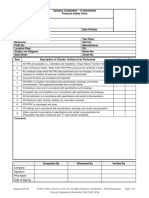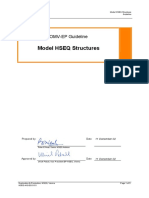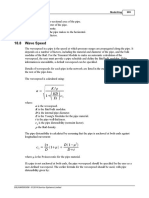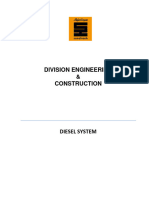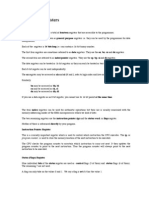Ref N° 24 - PRODUCED WATER HANDLING - PHILOSOPHY
Ref N° 24 - PRODUCED WATER HANDLING - PHILOSOPHY
Uploaded by
lxz861020Copyright:
Available Formats
Ref N° 24 - PRODUCED WATER HANDLING - PHILOSOPHY
Ref N° 24 - PRODUCED WATER HANDLING - PHILOSOPHY
Uploaded by
lxz861020Original Title
Copyright
Available Formats
Share this document
Did you find this document useful?
Is this content inappropriate?
Copyright:
Available Formats
Ref N° 24 - PRODUCED WATER HANDLING - PHILOSOPHY
Ref N° 24 - PRODUCED WATER HANDLING - PHILOSOPHY
Uploaded by
lxz861020Copyright:
Available Formats
DIVISION ENGINEERING
&
CONSTRUCTION
PRODUCED WATER HANDLING
PHILOSOPHY
CONTENTS
1. INTRODUCTION
1.1. FOREWORD
1.2. OBJECTIVES
1.3. SCOPE
2. HEALTH, SAFETY AND ENVIRONMENTAL REQUIREMENTS
3. FUNCTIONAL REQUIREMENTS
3.1. GENERAL
3.2. SYSTEM CONFIGURATION
3.3. HYDROCYCLONES
3.4. PUMPS
3.5. CONTROL VALVES
3.6. DEGASSER VESSELS
3.7. FILTRATION
3.8. CHEMICAL INJECTION
3.9. SAMPLING & ANALYSIS
3.10. FLEXIBILITY
3.11. CORROSION & EROSION
4. SPARING AND MAINTENANCE REQUIREMENTS
5. LOCATION AND ACCESS REQUIREMENTS
6. START-UP REQUIREMENTS
7. COMMISSIONING REQUIREMENTS
PRODUCED WATER HANDLING
PHILOSOPHY Page 2
1. INTRODUCTION
1.1. FOREWORD
This document represents the Sonatrach(SH) Operational Philosophy on
Produced Water Handling for projects in Algeria.
1.2. OBJECTIVES
The primary objective of this document is to provide guidance to discipline
engineers in progressing a conceptual design through to detailed design, based
on operational requirements
1.3. SCOPE
The philosophy requirements apply to all items of equipment used in the handling
of produced wate
2. HEALTH, SAFETY AND ENVIRONMENTAL REQUIREMENTS
All facilities installed shall comply with the HSE Philosophy requirements in
addition to the following:
2.1 Produced water systems normally give rise to an HP/LP interface between
upstream production systems and downstream degassing and treatment
equipment. The design shall provide adequate protection facilities for scenarios
such as gas blow by.
2.2 Effluents from the produced water system should be disposed of in an
environmentally acceptable manner when normal disposal routes (oil recycled to
process, water to re-injection) are not available. The use of large evaporation
ponds are not acceptable.
PRODUCED WATER HANDLING
PHILOSOPHY Page 3
3. FUNCTIONAL REQUIREMENTS
3.1. GENERAL
3.1.1 The produced water handling facilities shall remove the oil and
particulates from the produced water to the specifications stated in the Basis
of Design. The recovered oil shall be recycled and clean water routed to
water injection system.
3.1.2 The equipment shall be capable of achieving the produced water
specifications over the full range of compositional variation, ambient
conditions, at maximum design rates and at turndown rates.
3.2. SYSTEM CONFIGURATION
3.2.1 The system configuration should be established based on optimisation
with respect to:
Maximise re-injection of produced water.
Minimisation of environmental emissions and effluents.
Operating pressure at each separation stage.
Fluid properties (wax, foam, emulsions, etc.).
Minimise foaming and emulsions.
3.2.2 Consideration should be given to the best available technologies for
produced water handling and their relative merits. For example,
hydrocyclones may be the most suitable for offshore environments due
to their small size, but for onshore plants, technologies such as tilted
plate separators may be more economic due to space and weight
being less of an issue.
3.2.3 The pipework configuration shall account for any possible sand
contained in the produced water and the possibility of blockage.
Consideration shall be given to the future provision of sand removal
facilities (e.g. sand cyclones) on upstream systems.
3.2.4 Consideration shall be given to the compatibility of different produced
water streams that could give rise to scale formation if mixed.
Segregation of such streams shall be considered when determining
overall system configuration.
PRODUCED WATER HANDLING
PHILOSOPHY Page 4
3.3. HYDROCYCLONES
If hydrocyclones are used in the processing of produced water, the following
requirements shall be followed.
3.3.1 The design shall allow future retrofit of enhanced coalescence devices
such as Cyclotech PECT-F.
3.3.2 Facilities shall be installed to allow each hydrocyclone vessel to be
back-flushed to prevent blockages.
3.3.3 The hydrocyclone liner arrangement shall be initially set up to suit
predicted start-up water rates. This could involve removing supplied
liners and installing blanks. It is important that a record is made of the
initial set –up. This shall be done by means of P&ID mark-up, a note in
the equipment records and attaching an information tag. Spare liners
shall be kept in stores.
3.3.4 The trims supplied with control valves shall be suitable for the predicted
start-up water rates. This may mean that a trim change or valve
change-out is required for the maximum water case, which tends to
occur late in field life. The ability to do this shall be incorporated in the
plant design.
3.3.5 Isolation should be provided to allow an off-line hydrocyclone vessel to
be isolated and dismantled to allow cleaning, repair or insertion and
removal of liners. On-line cleaning facilities (e.g. jetting nozzles)
should also be considered.
3.3.6 Vent and drain connections will be provided to allow each hydrocyclone
vessel to be taken offline and dismantled individually. Drain
connections in produced water service should be routed to Closed
Drains, however care should be taken to ensure sand/solids are not
routed to the drains.
3.3.7 Sample points shall be provided at the inlet, outlet and reject streams
of each hydrocyclone vessel to enable assessment the hydrocyclone
vessel performance.
3.3.8 Valved connections shall be provided to allow the on-line fitting of local
pressure gauges to all inlet and outlet lines of each hydrocyclone
vessel.
3.3.9 Hydrocyclone liner types shall be common throughout the facility. This
is to allow optimum selection of the number of provided liners.
PRODUCED WATER HANDLING
PHILOSOPHY Page 5
3.4. PUMPS
3.4.1 Fitting pumps upstream of water / oil separation equipment should be
avoided if possible. The practice of recycling produced water to a
higher-pressure separator for entry into the produced water processing
system should also be avoided if possible.
3.4.2 Pumps fitted in the produced water system should be designed as low
shear. The design shall be robust and able to withstand vibration, and
corrosion. They shall also be resistant to the presence of sand in the
produced water, if sand production is expected. The design shall avoid
the need for any inline items that could cause droplet shear.
3.4.3 Upstream vessels shall be elevated sufficiently to ensure that net
positive suction head (NPSH) requirements of any associated pumps
are met. Pump NPSH calculations shall take into account the
presence of oil in water, which will increase the vapour pressure of the
pumped fluid. Available NPSH shall be verified once piping isometrics
are produced and checked against the actual NPSH requirements
specified by the supplier. All such calculations shall be traceable.
NPSH calculations shall include maximum pressure drop across
suction strainers.
3.4.4 Pump suction strainers shall be provided. The strainers shall be easy
to access and change out (e.g. lift-out basket type) for critical service
parallel units should be considered. A local differential pressure gauge
shall be provided. Strainers shall be robust and be capable of being
cleaned by a water pressure jet. Low suction pressure trip devices
should be located downstream of the strainer.
3.4.5 The design pressure of discharge pipework from centrifugal pumps
shall be adequate for the maximum pump head to avoid the need for
relief valves. Account shall be made for the presence of high density
liquid such as water and upstream vessels operating at above normal
pressures. Calculation results and assumptions shall be recorded on
the pump data sheet in case a future impeller upgrade is considered.
The design should consider future impeller change.
3.4.6 Casing drains for pumps in produced water service shall be piped to
closed drains.
3.4.7 Pumps should be designed to allow future impeller change, the
selected pumps shall not use the largest impeller available to allow
future upgrade.
PRODUCED WATER HANDLING
PHILOSOPHY Page 6
3.5. CONTROL VALVES
3.5.1 Any control valves required upstream of water / oil separation
equipment should be designed to minimise the shear on the oil / water
liquids.
3.5.2 Provision of dual control valves shall be considered to address
blockage and erosion due to sand or high-pressure drop across the
valve. Erosion resistant trim materials shall be used.
3.5.3 The potential for cavitation of the produced water shall be considered
and addressed, especially for services where flow is from a pressurised
source into a low pressure or atmospheric system. Consideration shall
be given to installing such valves at a low point so that there is a
constant static head back pressure on the valve outlet.
3.5.4 Control valves need to be readily accessible and robust to allow easy
cleaning as they are a likely site for scale deposition.
3.6. DEGASSER VESSELS
If a degasser vessel is required to meet the specifications as stated in the
Basis of Design, the following shall be followed:
3.6.1 Gas liberated from a produced water degasser vessel should be routed
to a low-pressure flare system for disposal.
3.6.2 In order to confirm degasser size and suitability of internals to achieve
the required separation consideration should be given to computational
fluid dynamic (CFD) analysis and/or laboratory tests.
3.6.3 Skimming facilities shall be provided to allow removal of accumulated
oil on the liquid surface to a suitable collection system. This is to be a
manual operation. Appropriate layout will allow gravity flow rather than
requiring a pump.
3.6.4 Degasser inlet device design shall be such that it allows liberated gas
bubbles to assist in ‘floating’ oil droplets to the surface and thus
enhance separation efficiency.
3.6.5 In the sizing of a produced water degasser, the equivalent residence
time between normal operating and alarm level and between alarm
level and trip shall be sufficient to allow operator intervention.
3.6.6 When sand production is likely, the degasser shall be equipped with
proven sand washing facilities.
PRODUCED WATER HANDLING
PHILOSOPHY Page 7
3.6.7 When sand production is expected, the outlet to instrument bridles on
the degasser shall be protected against blockage. Level bridle nozzles
on vessel bottoms should be avoided. Otherwise, inserts are to be
installed.
3.7. FILTRATION
3.7.1 Filters fitted in the produced water processing systems shall be
configured with at least one off-line stand-by unit at all times. The off-
line unit shall have sufficient isolation valves / spading points to allow
the unit to be dismantled for cleaning while the other unit is on-line.
3.7.2 Back-flushing facilities shall be installed on all filters in produced water
service. Water for back flushing should be taken from a suitable
source e.g. downstream of water injection booster pumps. The water
from back flushing should be recovered and recycled. Consideration
shall be given to routing the flushed material to sand handling facilities
or a backwash tank to recover sand/solids before routing the material
to drainage.
3.7.3 An adjustable timer should be considered to initiate backwash
automatically, with an over-ride from a high differential pressure. The
backwash shall be able to be initiated manually from the CCR.
3.7.4 A flow sharing system should be installed to prevent a filter that has
been backwashed from accepting more than its design flow.
Restriction orifice plates or preferably, a flow control loop may achieve
this for each unit.
3.7.5 Pressure differential instrumentation shall be provided to monitor the
condition of the filters while in service. Filters in essential service shall
be monitored from the CCR, with alarms to warn the CCR personnel
when the filter requires to be changed / cleaned or the backwash has
failed.
3.7.6 Vent and drain connections shall be provided on each filter unit to allow
the unit to be drained prior to opening the unit.
3.7.7 Drain connections from produced water filter units shall be piped to
Closed Drains.
3.8. CHEMICAL INJECTION
3.8.1 An appropriate connection suitable for deoiler chemical injection should
be provided on the produced water outlet line from each production
vessel. Adequate space shall be provided around the connection to
allow the fitting of a mechanically robust injection quill that is on-line
PRODUCED WATER HANDLING
PHILOSOPHY Page 8
retrievable. The space provided shall allow use of an appropriate
extraction tool for this purpose.
3.8.2 De-oiling chemicals may be toxic and should therefore be avoided by
proper design and operation where possible.
3.8.3 Individual chemical injection points shall be provided upstream all
separator inlets for antifoam, demulsifier, etc. Injection quills shall be
used. These shall be removable under line pressure and mechanically
robust for main process line flow rate and condition (e.g. slugging).
3.9. SAMPLING & ANALYSIS
3.9.1 Sampling points shall be provided with sampling quills. These shall be
removable under line pressure and mechanically robust for main
process line flow rate and condition (e.g. slugging). Adequate space
shall be provided to allow use of an appropriate extraction tool.
3.9.2 Double block and bleed isolation will be provided on all sample points.
3.9.3 Sampling points on produced water lines shall be provided with a
connection to Closed Drains for flushing the sample point prior to
taking a sample. Sample points may need to be continually flushed to
ensure collection of a representative sample.
3.9.4 The design of the sampling points shall ensure that the gas liberated
when sampling will not activate gas detectors.
3.9.5 A sample point shall be provided at each outlet of the produced water
processing system. This sample point shall have the capability of
isokinetic sampling for oil-in-water content and analysis of sand
content.
3.9.6 Production lab shall have adequate facilities to allow determination of
oil in water content. Determination techniques shall be suitable for the
nature of the fluids.
3.9.7 In line analysers fitted to the system shall be of proven service on a
system in similar duty.
3.10. FLEXIBILITY
3.10.1 Where parallel equipment is used such as a number of hydrocyclone
vessels, the isolation and control configuration should allow each piece
of equipment to be operated independently (i.e. different pressures) so
PRODUCED WATER HANDLING
PHILOSOPHY Page 9
long as it does not affect the stable operation of upstream or
downstream equipment.
3.10.2 If water injection is not available the cleaned produced water shall be
disposed to an alternative location, e.g. retention pond. The water
quality shall meet requirement for such alternative routes.
3.11. CORROSION & EROSION
3.11.1 Produced water is a corrosive fluid. This shall be considered in the
material selection. The erosion caused by any sand production shall
also be considered during material selection.
3.11.2 The layout of produced water system shall ensure any leaks does not
cause corrosion of other equipment
4. SPARING AND MAINTENANCE REQUIREMENTS
4.1 Reject oil control valves tend to have small trim sizes and therefore are
prone to blockage. Due to their small size, a spare valve shall be kept in
stock to allow rapid change-out.
5. LOCATION AND ACCESS REQUIREMENTS
5.1 The pipework between the production vessels and the produced water
handling system should slope towards the produced water handling
system.
5.2 For hydrocyclones, the main inlet and outlet vessel connections shall be
located on the vessel bottom. Hydrocyclone liners shall be installed from
the top downwards and be easily removable from the vessel. This is to
mitigate blockages due to sand, scale, etc
6. START-UP REQUIREMENTS
6.1 Consideration shall be given to the requirement to recycle any off spec.
product that may result from start-up activities.
6.2 Produced water will have to be recycled to clean-up system before forward
flow for re-injection is permitted.
7. COMMISSIONING REQUIREMENTS
7.1 All hydrocyclone vessels should be opened prior to commissioning to
check the quantity of liners that are installed, the fitted parts are as per
design, and that the parts inside the vessel have not been damaged in
transit.
PRODUCED WATER HANDLING
PHILOSOPHY Page 10
Prior to commissioning, a test-run should be carried out with utility water to
ascertain the pressure profile across the system. It is recommended that a
number of different flowrates are used, and the profile checked against the
design information. Additional local pressure gauges should be fitted for the
test as deemed appropriate. Any discrepancies shall be referred to the
package vendor for advice
PRODUCED WATER HANDLING
PHILOSOPHY Page 11
You might also like
- Civil Engineering Words in EnglishDocument17 pagesCivil Engineering Words in EnglishMateus PachecoNo ratings yet
- 10 1016@j Jngse 2016 01 016Document37 pages10 1016@j Jngse 2016 01 016saiful bahriNo ratings yet
- 2ZZ-GE Engine DescriptionDocument9 pages2ZZ-GE Engine DescriptionJordan DerrickNo ratings yet
- Big Data Camp Intro HadoopDocument22 pagesBig Data Camp Intro Hadoopindoos2000No ratings yet
- EBS1 FPFA00 SAPI RQMA 1032 D00 Technical Requisition For Ball Valve 16"Document27 pagesEBS1 FPFA00 SAPI RQMA 1032 D00 Technical Requisition For Ball Valve 16"AhmedNo ratings yet
- CMIT-801-BECO-15.81-18005 Project Execution PlanDocument142 pagesCMIT-801-BECO-15.81-18005 Project Execution PlanRAZANo ratings yet
- Basis of Design and Report Index - Rev2 - GPP OnlyDocument32 pagesBasis of Design and Report Index - Rev2 - GPP OnlyHamed MolaviNo ratings yet
- Engineering 003-Civil Structural Design Criteria On ShoreDocument22 pagesEngineering 003-Civil Structural Design Criteria On Shoremarin cristian100% (2)
- Hassi Bir Rekaiz Field Development Phase1: Process Data Sheet Front End Engineering DesignDocument6 pagesHassi Bir Rekaiz Field Development Phase1: Process Data Sheet Front End Engineering Designahmed.njahNo ratings yet
- الخليجDocument10 pagesالخليجmohamedNo ratings yet
- SGGP Reference No: P0116-TAK-P01-0023-02Document16 pagesSGGP Reference No: P0116-TAK-P01-0023-02Jabel Oil Services Technical DPTNo ratings yet
- Passive Fire Protection Specification: in Amenas Gas Project AlgeriaDocument33 pagesPassive Fire Protection Specification: in Amenas Gas Project AlgeriaDaoued HaouesNo ratings yet
- HSE-004 - Rev 0 PDFDocument43 pagesHSE-004 - Rev 0 PDFbaranakinbingolNo ratings yet
- LNG UVCE MitigtionDocument47 pagesLNG UVCE MitigtionVăn HoàngNo ratings yet
- Annex 17 - Induction Nawara ProjDocument18 pagesAnnex 17 - Induction Nawara ProjMajdiSahnounNo ratings yet
- 27617E01 Design Criteria For Liquid Hydrocarbons FISCAL METERING SYSTEMDocument65 pages27617E01 Design Criteria For Liquid Hydrocarbons FISCAL METERING SYSTEMThirukkumaranBalasubramanianNo ratings yet
- RPT 7006 H0 SS3 50 00 001 0Document19 pagesRPT 7006 H0 SS3 50 00 001 0NikradNo ratings yet
- Australia Pacific LNG ProjectDocument78 pagesAustralia Pacific LNG ProjectkrishnaNo ratings yet
- 7.1.1 AAM HSE General Safety Standards - Design SpecificationsDocument41 pages7.1.1 AAM HSE General Safety Standards - Design SpecificationsIVAN ORTIZNo ratings yet
- Coral FLNG SA Is The Special Purpose Entity Responsible To Develop and Operate Coral South Floating Platform (FLNG)Document4 pagesCoral FLNG SA Is The Special Purpose Entity Responsible To Develop and Operate Coral South Floating Platform (FLNG)MateusPauloNo ratings yet
- PDO SP 1127 Plant Equipment Layout SpecificationDocument13 pagesPDO SP 1127 Plant Equipment Layout Specificationrishiraj goswamiNo ratings yet
- Idbu-Ed-Fspds-000014 Rev C (Human Factor)Document113 pagesIdbu-Ed-Fspds-000014 Rev C (Human Factor)aan2014211No ratings yet
- CPMS-AUT-ES-001 - Instrument and Control Philosophy StandardDocument8 pagesCPMS-AUT-ES-001 - Instrument and Control Philosophy StandardChrisNo ratings yet
- Witness Joint & Sampling MatrixDocument13 pagesWitness Joint & Sampling MatrixPazhamalai RajanNo ratings yet
- Method Statement For Ohl Shutdown WorkDocument19 pagesMethod Statement For Ohl Shutdown Workoption.trader.bilalNo ratings yet
- SIL LOPA Presentation 19th June 2016Document38 pagesSIL LOPA Presentation 19th June 2016endahsasmita96No ratings yet
- DP OPSON 0144 DUSUP Guidelines For Land Use PlanningDocument15 pagesDP OPSON 0144 DUSUP Guidelines For Land Use PlanningAntuanet SaldañaNo ratings yet
- Eglobp 00 El Ell 002 - 0Document7 pagesEglobp 00 El Ell 002 - 0Ahmed Moharram100% (1)
- Comonomer PurificationDocument2 pagesComonomer PurificationJuvielyn Garcia100% (1)
- PSM Project PhasesDocument23 pagesPSM Project PhaseskarimNo ratings yet
- GP 14-01 Noise ControlDocument12 pagesGP 14-01 Noise Controlzepol051No ratings yet
- Onshore Terminal For KG DWN 98/2 Development Project Doc. NoDocument15 pagesOnshore Terminal For KG DWN 98/2 Development Project Doc. NoalokcNo ratings yet
- 15-501-EP-LI-002 - Rev - 1 (Tie in List)Document2 pages15-501-EP-LI-002 - Rev - 1 (Tie in List)Umair A. KhanNo ratings yet
- Shg-Sf-Ep-800-0006 - Rev0 - Afd - Passive Fire Protection Philosophy (Phase 3 Feed)Document27 pagesShg-Sf-Ep-800-0006 - Rev0 - Afd - Passive Fire Protection Philosophy (Phase 3 Feed)T-ru Loga RajanNo ratings yet
- EOL-Engg-M-001 - R1 - Tank Product Pipeline Hydro Testing Doping and InstallationDocument11 pagesEOL-Engg-M-001 - R1 - Tank Product Pipeline Hydro Testing Doping and InstallationRanjit MandalNo ratings yet
- Spec - 2017-02 - A01-NOISE CONTROL InfoDocument21 pagesSpec - 2017-02 - A01-NOISE CONTROL InfoshaileshgadbailNo ratings yet
- CH134R003 PDFDocument67 pagesCH134R003 PDFKids StrolaNo ratings yet
- ICM-CD-6119.06 Check Sheet PSVDocument1 pageICM-CD-6119.06 Check Sheet PSVShivani DubeyNo ratings yet
- SPSP Certification Request Form - 20221003Document1 pageSPSP Certification Request Form - 20221003ali othmanNo ratings yet
- Model HSEQ Structures: OMV-EP GuidelineDocument5 pagesModel HSEQ Structures: OMV-EP GuidelineMoaatazz NouisriNo ratings yet
- IONE-VP-02-H-001-075 - Rv11 - C - INSTRUMENT ALARM AND TRIP LIST - R11Document3 pagesIONE-VP-02-H-001-075 - Rv11 - C - INSTRUMENT ALARM AND TRIP LIST - R11dhiaa mohammedNo ratings yet
- Drainage PhilosophyDocument5 pagesDrainage PhilosophyabhmarsNo ratings yet
- SE-HIO-4AEL-MST-0014 Testing and Commissioning of Wires and Single Core CableDocument11 pagesSE-HIO-4AEL-MST-0014 Testing and Commissioning of Wires and Single Core Cablevishwas salunkheNo ratings yet
- Feb 10Document29 pagesFeb 10c_nghia100% (1)
- SPCC C SH PR 0024 Project Environmental Monitoring Plan F1Document18 pagesSPCC C SH PR 0024 Project Environmental Monitoring Plan F1ismayil AdishovNo ratings yet
- Rapid Risk Assessment Report For Pipeline From Jetty To BPCL Coastal Installation at HaldiaDocument69 pagesRapid Risk Assessment Report For Pipeline From Jetty To BPCL Coastal Installation at Haldiasachin nagavkarNo ratings yet
- Ngc1 Epcc Exe Kqks Sbnro PMG MPR 011 (May 22)Document86 pagesNgc1 Epcc Exe Kqks Sbnro PMG MPR 011 (May 22)hanafiNo ratings yet
- PR-1710 - Lifting Equipment Numbering ProcedureDocument36 pagesPR-1710 - Lifting Equipment Numbering Procedurefananman80No ratings yet
- Loss Prevention Bulletin Vol.50 FullDocument68 pagesLoss Prevention Bulletin Vol.50 FullPippo TopolinoNo ratings yet
- ABB-GEN-CNS-MOS-GPS-16015-00002-U-00 - Earth Work For Off Loading FaciliDocument10 pagesABB-GEN-CNS-MOS-GPS-16015-00002-U-00 - Earth Work For Off Loading Facilisaravana.bNo ratings yet
- Philosophy of HSEDocument1 pagePhilosophy of HSEAmir Zad KhanNo ratings yet
- E Summary of Formulas: 1. DensityDocument21 pagesE Summary of Formulas: 1. Densitynestor chambiNo ratings yet
- 05 - Supply Mode Sprinkler in 22 FloorDocument16 pages05 - Supply Mode Sprinkler in 22 FloorShappan Abd AllhaNo ratings yet
- BP Amoco Oil Hazard and Operability Studies (Hazop)Document37 pagesBP Amoco Oil Hazard and Operability Studies (Hazop)Pedro DiazNo ratings yet
- MANITA Montassar CVDocument8 pagesMANITA Montassar CVMontassarNo ratings yet
- Pages From Pipenet Transient (Surge)Document2 pagesPages From Pipenet Transient (Surge)absahkahNo ratings yet
- Foam System Hydraulic Calculation ReportDocument18 pagesFoam System Hydraulic Calculation ReportmoodydoodyNo ratings yet
- Spec 2018-02 A00Document17 pagesSpec 2018-02 A00vikasamitabhNo ratings yet
- DGS-MU-008-R1 Plant Noise ControlDocument32 pagesDGS-MU-008-R1 Plant Noise ControlHalim KazdarNo ratings yet
- Petronas Technical Standards: Design of Pressure Relief, Flare and Vent SystemsDocument55 pagesPetronas Technical Standards: Design of Pressure Relief, Flare and Vent SystemsfardinaNo ratings yet
- Section 5 GposDocument21 pagesSection 5 GposDangolNo ratings yet
- Reverse Osmosis SpecsDocument3 pagesReverse Osmosis SpecsHussein Adnan FneishNo ratings yet
- Pressure Filter Design and Installation GuidelinesDocument9 pagesPressure Filter Design and Installation GuidelinesTajudeen Ibrahim0% (1)
- 008.4 - EXHIBIT G - Attachment G4Document9 pages008.4 - EXHIBIT G - Attachment G4lxz861020No ratings yet
- Ref N° 25 - POTABLE WATER DESIGN PHILOSOPHYDocument8 pagesRef N° 25 - POTABLE WATER DESIGN PHILOSOPHYlxz861020No ratings yet
- Ref N° 2 - Codes & StandardsDocument24 pagesRef N° 2 - Codes & Standardslxz861020No ratings yet
- Ref N° 23 - DIESEL SYSTEM PHILOSOPHYDocument7 pagesRef N° 23 - DIESEL SYSTEM PHILOSOPHYlxz861020No ratings yet
- Ref N° 1 - DESIGN PHILOSOPHYDocument39 pagesRef N° 1 - DESIGN PHILOSOPHYlxz861020No ratings yet
- Ref N° 4 - FUEL GAS SYSTEM - DESIGN PHILOSOPHYDocument12 pagesRef N° 4 - FUEL GAS SYSTEM - DESIGN PHILOSOPHYlxz861020100% (2)
- Ref N° 3 - LINE SIZING PHILOSOPHYDocument16 pagesRef N° 3 - LINE SIZING PHILOSOPHYlxz861020No ratings yet
- Check List For 082-07-13 - A - P&ID FOR TFT SUD SLUG CATCHERDocument2 pagesCheck List For 082-07-13 - A - P&ID FOR TFT SUD SLUG CATCHERlxz861020No ratings yet
- Reteach 4Document97 pagesReteach 4Spring BballNo ratings yet
- DifferntiationDocument2 pagesDifferntiationapi-245381923No ratings yet
- A Brief History of Swing DancingDocument3 pagesA Brief History of Swing DancingKrisha loraine GapacNo ratings yet
- Site-Uri de Torrent Cu User Si ParolaDocument3 pagesSite-Uri de Torrent Cu User Si ParolaMarius ViorelNo ratings yet
- 10000003728Document32 pages10000003728Chapter 11 DocketsNo ratings yet
- OJ6 US4 JBformiaDocument71 pagesOJ6 US4 JBformiaAr Shubham KumarNo ratings yet
- Price Ice BoxDocument2 pagesPrice Ice BoxHaffiz AtingNo ratings yet
- A Simple Guide To Your Company's Financial Statements: Understanding Where YOU StandDocument12 pagesA Simple Guide To Your Company's Financial Statements: Understanding Where YOU StandAnkurNo ratings yet
- Full Body Burden by Kristen Iversen - Reader's Group GuideDocument4 pagesFull Body Burden by Kristen Iversen - Reader's Group GuideCrown Publishing GroupNo ratings yet
- OSIMO - 2711 - Consent and Application For Direct PVVNL Connection PDFDocument5 pagesOSIMO - 2711 - Consent and Application For Direct PVVNL Connection PDFJayantJhambNo ratings yet
- Lpcxpresso546X8/540Xx Board User ManualDocument36 pagesLpcxpresso546X8/540Xx Board User ManualIgo Rafael Alves SilvaNo ratings yet
- Help For Calculating The Impeller Tip Speed To Avoid Excessive Erosion Due To Suspended ParticlesDocument22 pagesHelp For Calculating The Impeller Tip Speed To Avoid Excessive Erosion Due To Suspended Particlesmihai37No ratings yet
- Steel SpecificationsDocument6 pagesSteel SpecificationsinsidereaderNo ratings yet
- NORTH EAST REGION of IndiaDocument44 pagesNORTH EAST REGION of IndiaEsha MacNo ratings yet
- UDSM - VACANCY - Assistant AccountantDocument2 pagesUDSM - VACANCY - Assistant AccountantEmmanuel YwfNo ratings yet
- Talent Guide 2021: Market, Challenges, Opportunities & Salary RangeDocument5 pagesTalent Guide 2021: Market, Challenges, Opportunities & Salary RangeHoaLQNo ratings yet
- Bdm100 User ManualDocument36 pagesBdm100 User Manualsimon_someone217No ratings yet
- LiquefactionproceduresJun99 PDFDocument70 pagesLiquefactionproceduresJun99 PDFKatherine Shayne YeeNo ratings yet
- Ships Particulars Normal Type 116 - Vers. 2021 04Document2 pagesShips Particulars Normal Type 116 - Vers. 2021 04Álvaro Rodríguez BNo ratings yet
- EST-SER-2024-4 PMC800 Trainning Services at JK Paper - Rev00Document7 pagesEST-SER-2024-4 PMC800 Trainning Services at JK Paper - Rev00HEMANT RAMJINo ratings yet
- Learning How To Hold The Guitar Pick CorrectlyDocument6 pagesLearning How To Hold The Guitar Pick CorrectlyKurgan GlNo ratings yet
- NAT Review Pre TestDocument6 pagesNAT Review Pre TestCher Z 2No ratings yet
- 8086 RegistersDocument3 pages8086 RegistersjerryNo ratings yet
- Number SystemDocument29 pagesNumber Systemsamana samiNo ratings yet
- 600 W Half Bridge LLC Eval BoardDocument65 pages600 W Half Bridge LLC Eval Boardsword2009No ratings yet
- Spectrally Resolved Franson InterferenceDocument13 pagesSpectrally Resolved Franson Interference蔡蓁羚No ratings yet
- Q2-Week 3- Grade 7- MUsic and ArtsDocument3 pagesQ2-Week 3- Grade 7- MUsic and Arts04deguzmanarielNo ratings yet





































